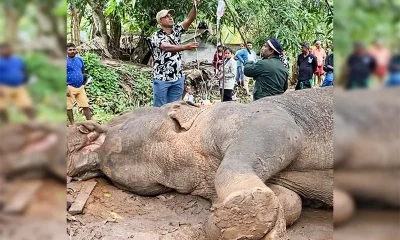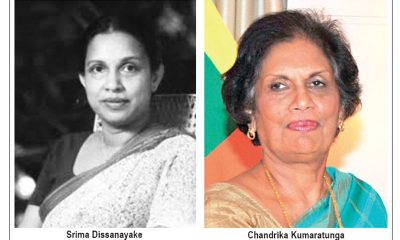News
Shortages: Auditor General’s report sheds light on many ills in health sector

By Saman Indrajith
The expenditure on medical supplies in the first quarter of 2022 was only Rs. 12.4 billion, a sharp drop from 2020 and 2021, the Auditor General’s Special Report on Procedures taken to avoid the Shortage of Pharmaceuticals in government hospitals by 13 May 2022, has revealed.
The amounts spent on medical supplies during the year 2020 and year 2021 were Rs. 83.5 billion and Rs. 73.6 billion respectively.
The actual quarterly average expenses on medical supplies in 2020 and 2021 were Rs. 20.8 billion and Rs. 18.4 billion respectively, the report has said.
The number of pharmaceutical items used in hospitals as Vital, Essential and Non-essential is 1,146; the number of surgical items is 8,648; the number of laboratory items is 3,900 and the number of the X-ray items is 44.
By 13 May, the number of Vital and Essential drugs out of stock in the Medical Supplies Division and hospitals was 190 and 51 respectively. Besides, 2,724 and 2,156 Vital and Essential surgical items were out of stock in the Medical Supplies Division and hospitals respectively at that time.
The number laboratory items and X-ray items out of stock in the Medical Supplies Division and hospitals was 850 and 18 respectively.The report says the future annual requirement is estimated by the respective hospital authorities based on the consumption and the remaining stocks, and sent to the Medical Supplies Division 13 months prior to the month in which the supply is required.
In the process of procuring medical supplies, the Medical Supplies Division has to send orders to the State Pharmaceutical Corporation for the procurement of estimated items with a supply period of 11 months.
The report has stated that the National Drug Quality Assurance Laboratory was established under the National Medicine Regulatory Authority to assist in the process of verifying the standards of procured medical supplies. Cabinet approval was given, on 15 October 2009, for the five-year Development Plan from 2010 to 2015, which was prepared at a cost of Rs. 410 million to develop the infrastructure and human resources of the National Pharmaceutical Quality Control Laboratory with a view to increasing the number of laboratory tests to check the quality of medical supplies.
According to the Manual on Management of Drugs, pharmaceuticals should be stored in well-ventilated spaces at specified temperatures. The Medical Supplies Division should maintain a secure stock for three months, and in addition to regular checks by a staff officer, sample testing should be done for the confirmation of the accuracy of drug storage and accounting.
The Auditor General’s report has said a number of other factors have contributed to shortages––poorly maintained computer system, lack of proper coordination and coordination between the Medical Supplies Division, the Ministry of Health, the State Pharmaceutical Corporation of Sri Lanka and the State Pharmaceutical Manufacturing Corporation of Sri Lanka, lack of regular monitoring, and progress of orders issued to the State Pharmaceutical Corporation of Sri Lanka and noncompliance with the procurement schedule.
The AG has found that the Medical Supplies Division submitted lists of orders for the respective year to the State Pharmaceutical Corporation of Sri Lanka through MSMIS or PRONTO computer system with a lead time of 11 months, but the corporation had not immediately commenced procurement process for those orders and the procurement was delayed until written copies of the order list were received by the corporation.
It took more than 18 days to send the written copies of the orders to the Import Division of the State Pharmaceutical Corporation, and since procurement had only begun thereafter, part of the supply period of 11 months had elapsed. Pharmacists and senior officials in the Medical Supplies Division placed the order through the computer system, but there had been a delay in sending written documents., the Auditor General has said.
Although 41 orders out of 90 for eight vital items and essential items were issued by the computer system to the State Pharmaceutical Corporation of Sri Lanka in the first two months of the year, it had taken between 18 days and six months for the Import Division of the State Pharmaceutical Corporation to receive the written copies of the order lists, the report found.
This shows that there is a lack of coordination among the Medical Supplies Division, Ministry of Health, State Pharmaceutical Corporation of Sri Lanka and State Pharmaceutical Manufacturing Corporation, which are mainly involved in the management of medical supplies, the Auditor General has observed in his report.
Latest News
IMF Executive Board approves US$206 Million in Emergency Financial Support for Sri Lanka

The IMF Executive Board approved emergency financing under the Rapid Financing Instrument (RFI), providing Sri Lanka with immediate access to SDR 150.5 million (about US$206 million,
equivalent to 26 percent of quota) to help Sri Lanka address the urgent needs arising from the catastrophic Cyclone Ditwah and preserve macroeconomic stability.
Latest News
Navy clears major bridge obstructions in Peradeniya and Lewella

In response to severe weather impacts, the Sri Lanka Navy conducted a diving and technical assistance operation on Friday (19 Dec 25) to clear major debris obstructing vital infrastructure.
Heavy rainfall caused a significant rise in the water level of the Mahaweli River, washed large quantities of debris, including logs and bamboo, downstream. These remain lodged in the Diyakapanathota in Gatambe, Peradeniya and Lewella bridges, obstructing the smooth flow of water.
Acting promptly upon request, a Navy diving team executed a coordinated operation in collaboration with the Road Development Authority. The team removed the accumulated debris, restoring normal water flow through the bridges.
Latest News
Landslide early warnings issued to the districts of Badulla, Kandy, Kurunegala, Matale and Nuwara-Eliya extended till 8AM on Sunday (21)

The Landslide Early Warning Centre of the National Building Research Organization (NBRO) has extended the Landslide Early Warning issued to the districts of Badulla, Kandy, Kurunegala, Matale and Nuwara-Eliya till 08:00AM on Sunday (21st December 2025)
The LEVEL III RED landslide early warnings issued to the Divisional Secetaries Divisions and surrounding areas of Medadumbara, Doluwa, Ududumbara and Minipe in the Kandy district, and Nildandahinna, Hanguranketha, Mathurata and
Walapane have been extended.
LEVEL II AMBER landslide early warnings have also been issued to the Divisional Secetaries Divisions and surrounding areas of Soranathota, Hali_Ela, Passara, Meegahakivula, Badulla, Lunugala and Kandeketiya in the Badulla district, Thumpane, Harispattuwa, Udapalatha, Kundasale, Akurana, Poojapitiya, Udunuwara, Pathadumbara, Pasbage Korale, Gangawata Korale, Hatharaliyadda, Yatinuwara, Ganga Ihala Korale, Panvila, Pathahewaheta and Deltota in the Kandy district, Rideegama in the Kurunegala district, Ukuwela, Naula, Matale, Ambanganga Korale, Rattota, Pallepola, Wilgamuwa, Yatawatta and Laggala Pallegama in the Matale district, and Nuwara-Eliya in the Nuwara-Eliya district.
LEVEL I YELLOW landslide early warnings have been issued to the Divisional Secetaries Divisions and surrounding areas of Uva Paranagama, Welimada, Haputhale, Haldummulla, Ella and
Bandarawela in the Badulla district, Alawwa, Mallawapitiya,
Polgahawela and Mawathagama in the Kurunegala district, and Kothmale East, Ambagamuwa Korale, Kothmale West, Thalawakele and Norwood in the Nuwara-Eliya district.
-

 Midweek Review4 days ago
Midweek Review4 days agoHow massive Akuregoda defence complex was built with proceeds from sale of Galle Face land to Shangri-La
-

 Features7 days ago
Features7 days agoWhy Sri Lanka Still Has No Doppler Radar – and Who Should Be Held Accountable
-

 News3 days ago
News3 days agoPakistan hands over 200 tonnes of humanitarian aid to Lanka
-

 News3 days ago
News3 days agoPope fires broadside: ‘The Holy See won’t be a silent bystander to the grave disparities, injustices, and fundamental human rights violations’
-

 Latest News6 days ago
Latest News6 days agoLandslide early warnings in force in the Districts of Badulla, Kandy, Kegalle, Kurunegala, Matale, Nuwara Eliya and Ratnapura
-

 News4 days ago
News4 days agoBurnt elephant dies after delayed rescue; activists demand arrests
-

 Features7 days ago
Features7 days agoSrima Dissanayake runs for president and I get sidelined in the UNP
-

 Editorial7 days ago
Editorial7 days agoDisaster relief and shocking allegations












